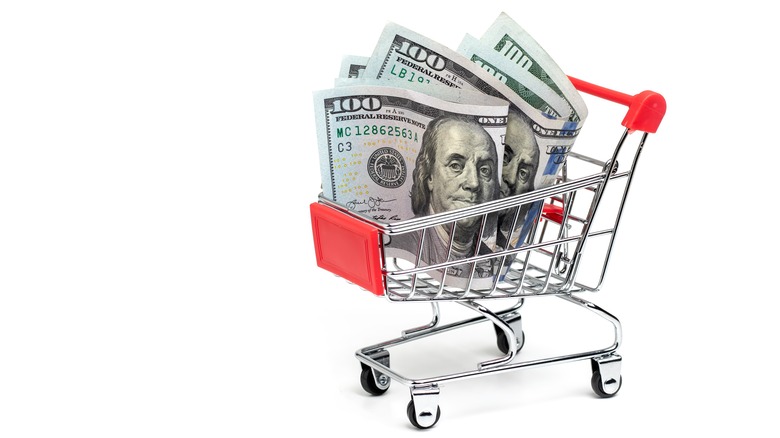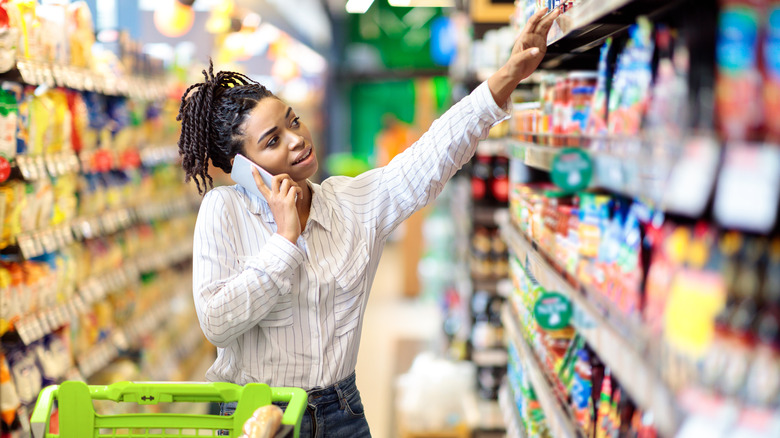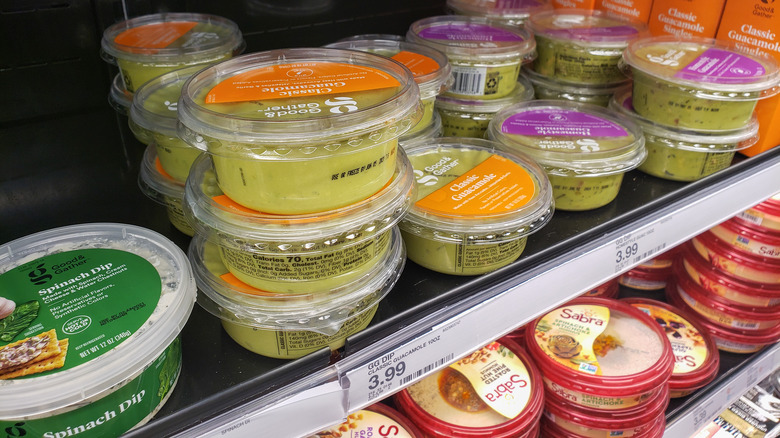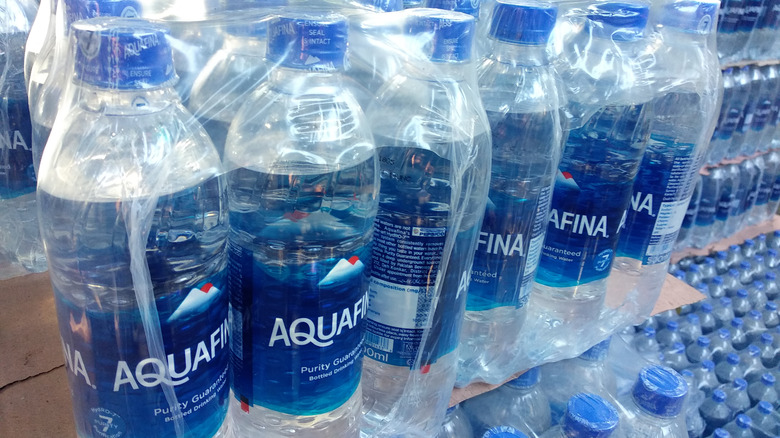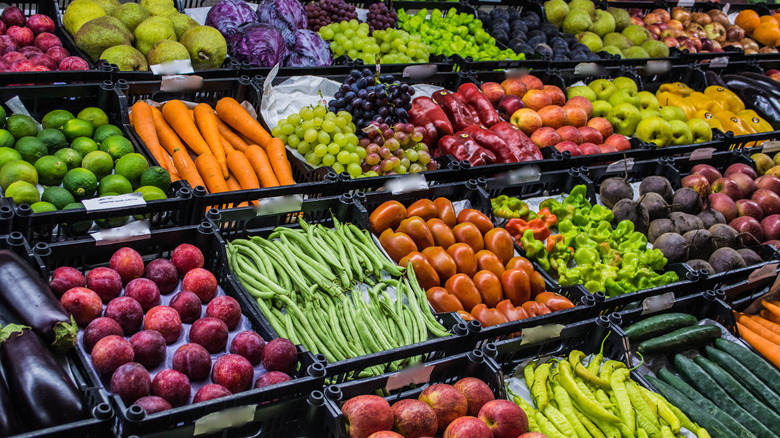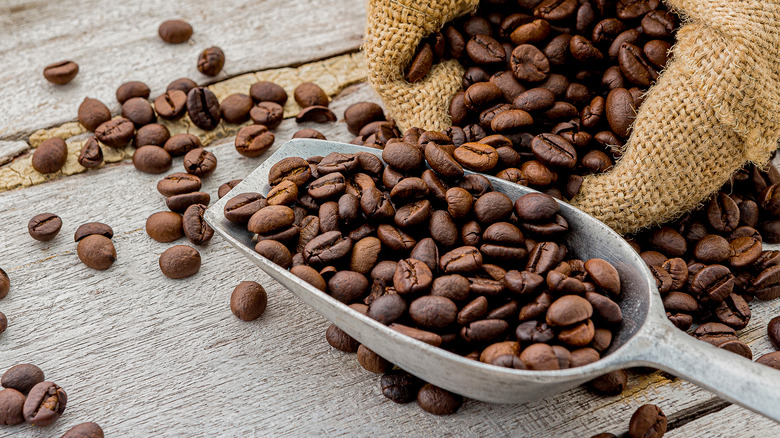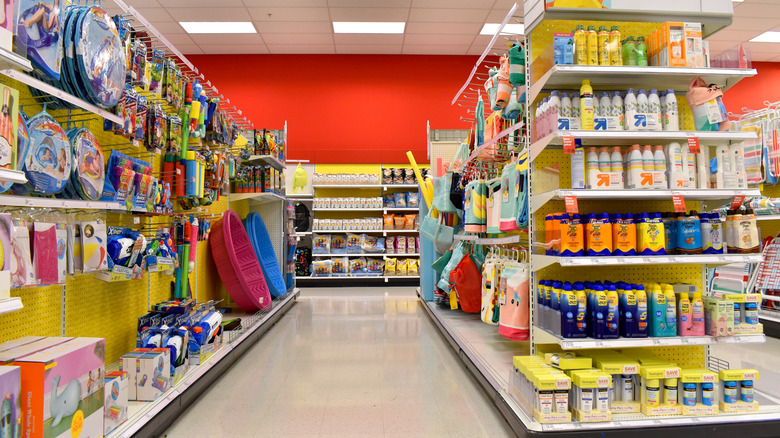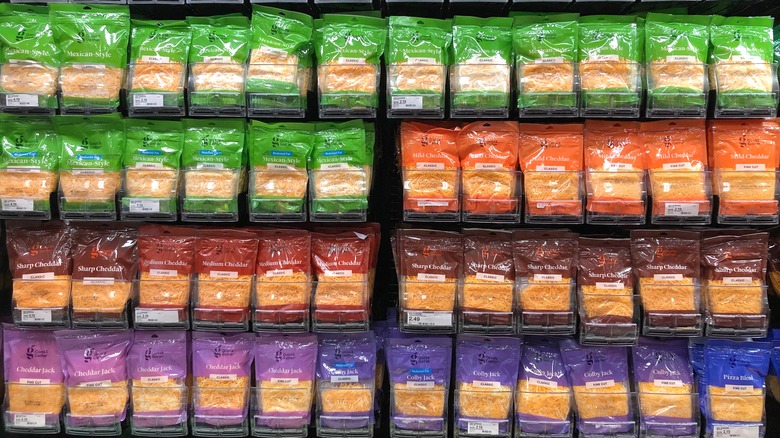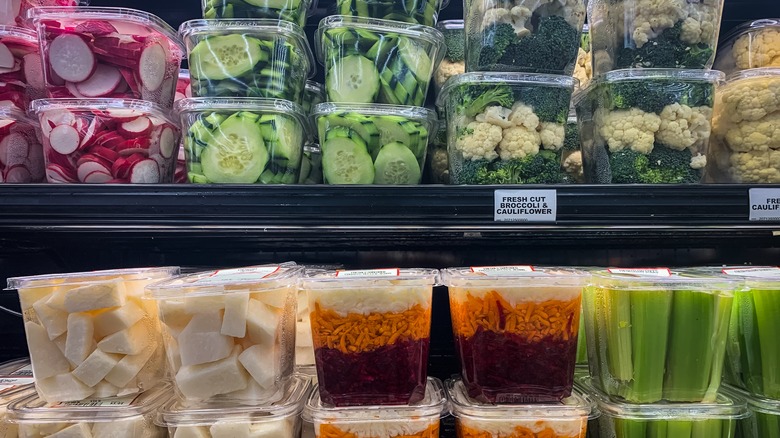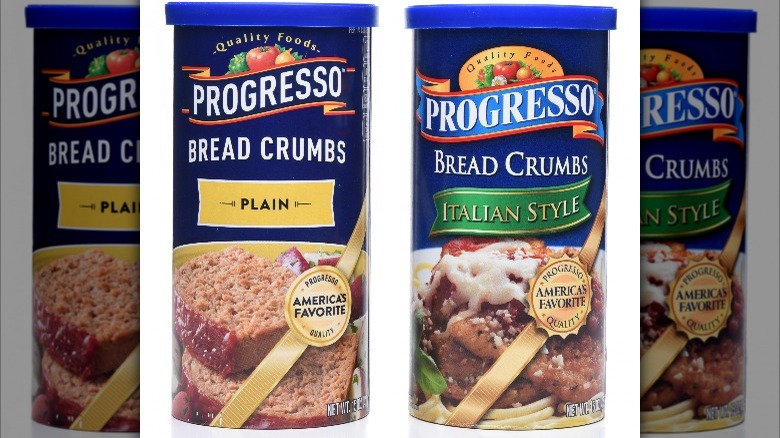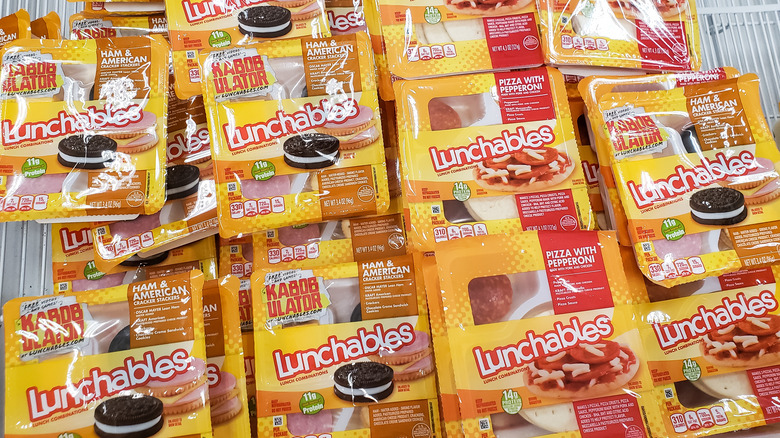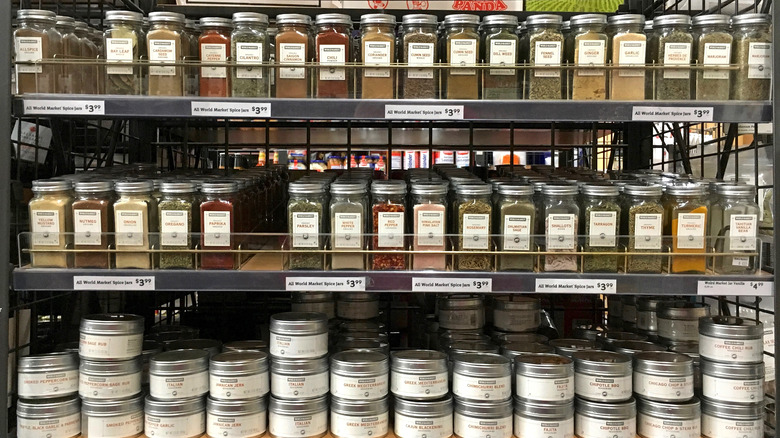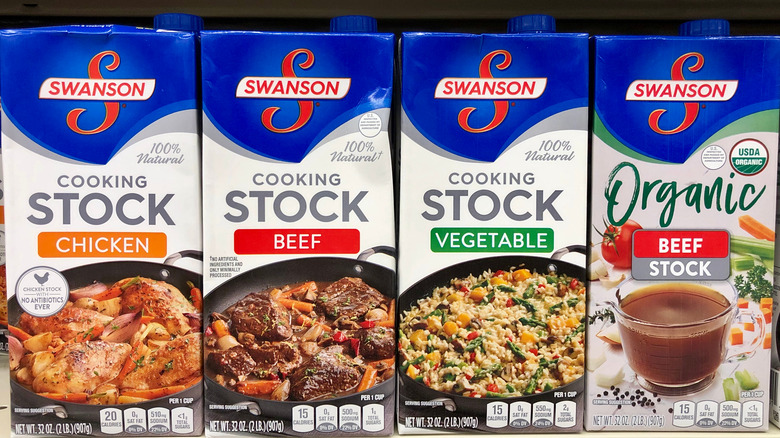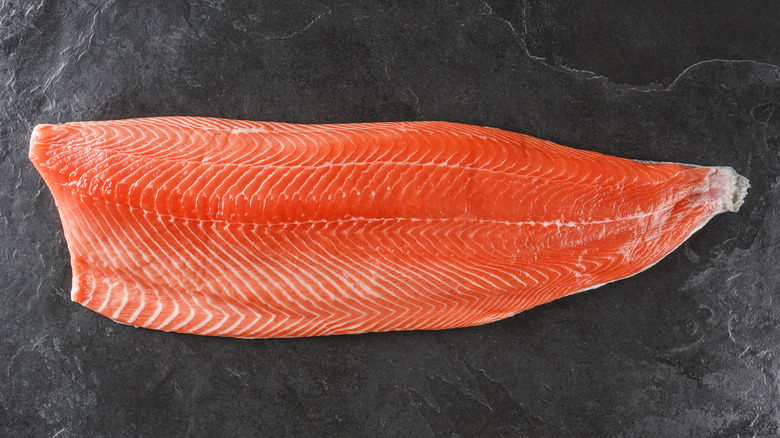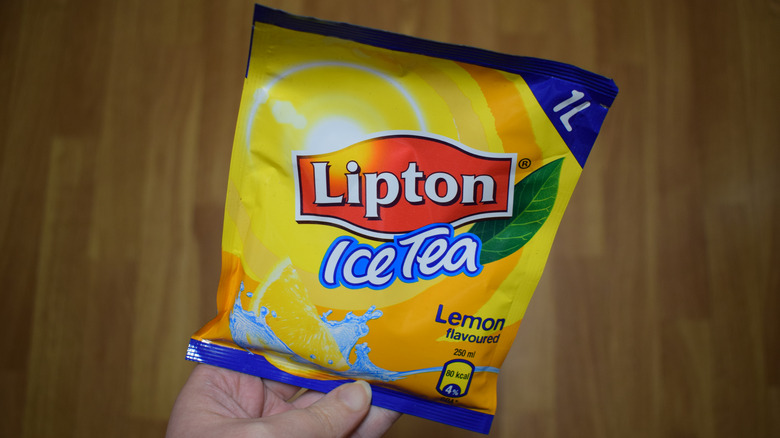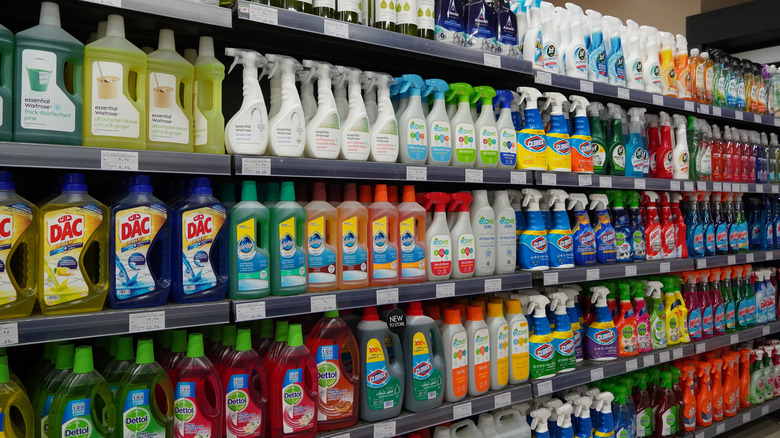Groceries You're Wasting Your Money On
Human beings eat with their eyes. If food looks good, then it should taste good. This goes back to our foraging days, as noted in a 2016 study published in Brain & Cognition. Our eyes allow us to recognize familiar foods and be wary of the unknown. We're also naturally drawn to shiny objects, a trait that is related to our desire for fresh water, as discovered in a 2014 study published in the Journal of Consumer Psychology. Oh, and being a savvy shopper or bargain buyer could actually be encoded in our DNA, as per Forbes.
If that's the case, then why do we spend so much on groceries that we end up tossing out? Per a survey by One Poll, the average shopper wastes almost $1,500 on food per year. How do you avoid caving and making useless purchases so that you can stop wasting money on food? The answers may be obvious, though less convenient. But hunting and gathering weren't really that convenient, either — they were about survival. Then again, this is survival of a different sort. So read on to see how you can save yourself some coin when you venture out to grab your grocery goods.
Items placed at eye level
The eye-level rule pertains mainly to the inner sections of your local grocery store: dry and packaged goods, cereals, canned food, and household supplies. According to visual marketing, product placement on store shelves can be split into four different levels (via Mobile Insight): stretch, eye, touch, and stoop. Brands pay a premium for placement at the eye and touch level since they are considered to be prime real estate, as noted by the marketing company Repsly.
Statistically, customers give the middle shelves 35% more attention than the stretch or stoop levels (via Leafio), simply because they are easier to access. Shorter individuals tend not to look up or buy from the stretch level because it's way up out of reach. Whereas the elderly or people with physical or mobility constrictions are generally unable to stoop down low.
Because these spots are more expensive for companies, the cost of the product will also be pricier for the customer. Someone has to pay that cost, and do you think the brand will happily fork it over? (Spoiler alert: The answer is no.) So the next time you're out shopping, remember to pay more attention to the top and bottom shelves; you're likely to find products you weren't aware of at a much more affordable price.
Spreads, dips, and salad dressings
If you've never had the pleasurable experience of eating a freshly made dip, spread, or salad dressing, then you're missing out. The best part is that they can be made with ingredients that you probably already have in your kitchen. Sure, there is some prep involved, but the cost is a fraction of what you would pay at the grocery store (and it will taste even better).
If hummus is your dip of choice, a basic recipe only requires canned garbanzo beans, extra virgin olive oil, tahini, and lemon juice. Tahini is the only item that is not considered to be a kitchen staple, according to Food Network. The ingredients are mostly quite cheap, and EVOO and tahini will come in handy in countless other recipes. Meanwhile, if you love guacamole, make a super simple mash of avocado, lemon or lime juice, salt, and pepper. A simple vinaigrette is just olive oil, salt, pepper, and balsamic vinegar — all kitchen staples. Want it creamy? Just add Greek yogurt or mayonnaise.
By making your own versions of these classics, you won't have to deal with a whole range of unpronounceable ingredients and additives — nitrates, acids, and benzoates — that sometimes even make people sick (via Verywell Health).
Bottled water
Though it's been continually documented that bottled water isn't anything special — a truth first admitted back in 2007 by PepsiCo who sells Aquafina (via CNN) — it's still being purchased in mass quantities. Frenzy buying sparked by natural disasters (or the pandemic) hasn't helped (via Los Angeles Times).
In an article published by The Guardian in 2021, the outlet stated that "the impact of bottled water on natural resources is 3,500 times higher than for tap water." Sure, the plastic bottles are recyclable, but that doesn't mean that the processing and packaging aren't still negatively impacting the environment and all its inhabitants, as documented in a 2009 press release by Harvard.
Unless you're living in an area where your municipal water isn't safe to drink, the economical thing to do is to get intimate with your tap water. Just drink it. According to the CDC, the public water system in the United States is one of the safest in the world. If the thought of drinking straight tap water still skeeves you out, consider investing in a filtration system. This can be as complex as a full kitchen upgrade or as simple as a pitcher. One Redditor shared that they saved $54 a year by switching to a pitcher. You can calculate how much you'll save by using a water filter savings calculator like BrizFeel. Remember: Bottled water is just tap water with a really cool brand story.
Out of season produce
If you think about it, having unlimited produce options available to you year-round seems a bit unnatural, doesn't it? That's because it is. Because of weather variations, fruits and vegetables have a specific growing season and shouldn't be continuously available on a whim. Webstaurant highlights the fact that these factors also depend on the region of the country that you live in.
If you purchase fruits and veggies that aren't being grown during their natural cycle, you can expect them to cost more. Have you ever bought a pint of blackberries in the summer and then, a month or two later, noticed that it costs at least a dollar or two more for the exact same amount? That's because in most of the U.S. peak blackberry season is July through August (via Gardening Know How). You might also notice that they just don't taste as sweet, tart, and juicy (but unfortunately, will still stain your fingers and clothes).
Produce begins to lose its nutritional value as soon as it's picked, according to a report written by Diane M. Barrett from the University of California, Davis in 2007. This becomes a problem if your strawberries, blueberries, or asparagus are being outsourced from distant farms and require longer transport times to reach the grocer. If you're still desperate for honeydew melon out of season, just purchase it frozen; you'll still get all the flavor and nutrients.
Coffee
Have you ever read the ingredients in the coffee you buy at your local grocer? The label probably lists 100% Arabica beans, since the majority of coffee in the U.S. comes from these (via Coffee Affection). You'll rarely see Robusta (Arabica's cousin) because it has a far more bitter taste, as The Roasterie explains. Basically, once you strip away the big brand name and the pretty bag, the main differences between packaged coffee are where the beans are sourced and how they are roasted.
You're going to pay more for a small 12-ounce bag o' beans because it has to travel, one Redditor describes. Coffee beans are transported from a roasting facility to the distribution hub and then to your local grocery store. That's a lot of miles to travel, gas to pay, and hands to pass through. And that is going to be reflected in the price you pay at your local market.
Do yourself (and your wallet) a favor and head over to a big box store like Costco or Sam's Club and purchase whole bean coffee in bulk. A store like Costco is able to pass on its epic deals to customers because of the massive quantities of products it purchases from its vendors. Invest in a coffee grinder and prepare it fresh daily; it will taste so much better and you'll be saving money.
Endcap and checkout lane items
If you've ever purchased items from an endcap or while waiting in the checkout line, you've fallen victim to the temptation trap. In an interview with Real Simple, consumer expert Paco Underhill says that up to two-thirds of what customers buy in a grocery store trip wasn't on their list. A lot of these unnecessary buys come from the way brands use prime shelf space to sling their products.
Endcaps are another spot considered ideal for big-ticket product placements. It's where brands can showcase everything from new products to discount and sale items, and even merchandise that has been discontinued (via Kitchn). Chances are you didn't really make a quick stop at the supermarket to buy eggs, bacon, English muffins, and two 12-packs of strawberry Fanta.
The checkout line is another tricky beast. You'll find an assortment of random tchotchkes that you definitely don't need (but think you do at that particular moment). Batteries might be necessary but not from the checkout line. Don't let your desire for shiny objects get the best of you; leave those Jack Link's and 3-for-1 Lindt truffles exactly where you found them — nestled amongst People Magazine, Time, and a mandala coloring book.
Shredded cheese
Sure, it might be easier to grab a bag of shredded cheese for Taco Tuesday and call it a day, but that's not really the best choice (for your finances at least). Remember how important it is to avoid eye-level purchases? The same goes for queso. According to Statista, in 2021 the national average for a 16-ounce block of cheese was $5.26. Meanwhile, an 8-ounce bag of Kraft shredded cheddar will run you $4.99 at Kroger. You do the math.
Shredded cheese isn't just a block of cheese that's been shredded and bagged. Some products contain a few extra ingredients like cellulose, which acts as a dehumidifier and sucks all the moisture from those delicate cheesy strands. It's called an anti-caking agent and it also slows down any potential mold growth. Sometimes your bag of shredded cheese will have a blend of ingredients like potato starch or cornstarch, calcium sulfate, and natamycin (another mold inhibitor), according to Eat This. Calcium sulfate (alias gypsum) is commonly used in baking and added to cement (via Bakerpedia).
Lastly, shredded cheese has more surface area, so it will end up growing the green stuff much faster than a block of cheese would. Looks like it's time to whip out that cheese grater you got as a gift half a decade ago.
Precut anything
Buying precut produce or deli items seems like a great idea. Your bell peppers, apples, and turkey are nicely sliced and you won't have to cry over onions. Unfortunately, other than saving you prep time, you're not going to reap much of a benefit. In a HuffPost interview with health and science journalist Max Lugavere, he explains that precut foods can be great for individuals who have a hard time maneuvering a knife and wouldn't eat produce otherwise. However, he mentions that besides paying more for less, there are some big reasons why shoppers should steer clear of conveniently prepackaged and proportioned produce, meats, and cheeses.
For one, precut foods are more prone to contamination from nasty bacteria like salmonella, E.coli, and listeria. In fact, Consumer Reports covered this exact issue in March 2022, when over 30 different types of precut produce were recalled due to a possible listeria outbreak. The food surface area increases when it's cut, which means faster spoilage due to oxidation. And then there's the not so environmentally-friendly plastic packaging that is used, because how else could your pre-portioned food be carried around? Just think of your prep time as a good chance to brush up on some important knife skills.
Bread crumbs
You bought a nice loaf of French bread three days ago, and it's been sitting on the kitchen counter waiting to be noshed on ever since. It's just hardening into a bread-shaped baton, no longer soft and fluffy — it can't even be sliced and used as crostini. You're probably entertaining the idea of tossing it, but why not get a bit creative?
Go ahead and smash that bread bat to pieces and create your own bread crumbs. If you don't feel like letting out some pent-up aggression on a stale loaf of bread, you can opt for a blender to grind it up instead. It's worth noting that celebrity personalities Ina Garten and Andrew Zimmern say you should never buy packaged bread crumbs. Homemade tastes far better and you'll avoid extra additives.
The best part about this trick is that one old loaf actually solves two issues: You'll avoid wasting money by throwing food away and you'll also save money by making your own bread crumbs. Doesn't that feel great, knowing you aren't forking over your hard-earned dollars for overpriced bread dust?
Packaged snack foods
Besides the fact that snack foods are housed in plastic (our poor planet is so sad right now), individual bites now fall under the pay more get less category, thanks to shrinkflation. (Yes, it's a term.) "Shrinkflation is a phenomenon that happens when the cost of goods goes up, so companies try to offset their higher costs by shrinking the product," NY Times bestselling author Nicole Lapin explains in a 2021 Forbes interview.
It comes down to the fact that customers will pay more attention to the price and less attention to what portion size they're actually getting from a beloved snack item. Food & Wine indicates that inflation is a major player here because prices are going up with no sign of plateauing, forcing suppliers to downsize the weight of their snacks while keeping prices relatively stable for consumers.
What does that mean for you? It's time to DIY your snacks. You can buy crunchy shelf-stable foods (like pretzels) in bulk at Costco or Walmart and whip up some easy snacks for when a craving strikes. Portion them out in reusable containers and you'll be helping to keep plastic bags out of the oceans. Even though it will take extra time, you'll ultimately be in control of what you're feeding yourself (and those around you), minimizing your environmental impact, and saving for your rainy day fund.
Herbs and spices
Chances are that if you check your spice cupboard, you're bound to have at least one dust-covered jar that only gets used for the holidays (basically once a year ... or less). The unfortunate part is that because it's seldomly used, whatever is in that jar has probably been sitting in your cupboard for way too long.
Healthline reports that herbs (dried plant matter) have a shelf life that ranges from one to three years. Whole spices last a bit longer — up to four years — because they're made from sturdier parts of a plant (seed pods, bark, roots, and stems), but you'll have to consume them within two to three years if they're ground. It's not that they go bad and will make you sick but they'll definitely lose their potency and aromatics, which could leave your cooking tasting a bit flat (via Webstaurant).
So when you're looking at your dusty spice rack, you're basically looking at a lot of money wasted. Instead of buying a jar of bay leaves (or juniper berries, cardamom pods, etc.), that will only see the light of day once in a blue moon, purchase only what you need. Some specialty food stores have bulk bin sections that allow you to measure out different herbs, spices, and even loose-leaf teas. You can also try to grow and dry your own herbs at home. A penny saved is a penny earned, right?
Stocks and broths
While it's not necessarily quicker to make your own soup stock at home, it is still relatively easy. The best part is that you can use leftover vegetable and meat scraps from your dinner prep. While broth and stock are often used interchangeably, there are slight differences between the two, according to Healthline.
Broth is made by simmering meat, vegetables, herbs, and spices to create a flavorful and light liquid. Stock, on the other hand, takes hours to make and technically only uses bones and cartilage. The result is a rich, flavorful, and thick base. Vegetables can also be added or used instead of bones. That being said, stock and broth are basically just water and kitchen leftovers; simply throw everything into a big pot with water and let it cook down.
There's really no point in overspending on a carton of broth when it can easily be whipped up at home using ingredients that you were just going to compost or toss. It may take a little more time but just think about all the money you'll be saving. Plus, it will be made with real ingredients that you've sourced, minus any weird additives, and it will definitely be a whole lot better than something you poured from a box. Doesn't that little financial victory taste delicious?
Certain organic foods
Organic foods are produced without the aid of chemical or synthetic substances (pesticides, fertilizer, dyes, antibiotics, etc.), per the USDA. It's not only good for the body, but it's incredibly beneficial for the planet too. Eating something that was possibly treated with chemicals somewhere down the line might give you the heebie-jeebies, and understandably so.
However, according to registered dietitian Amanda A. Kostro Miller, some fruits and vegetables have impermeable skins that protect the edible parts, making organic production less valuable in these cases (via The Healthy). Let's face it — organic food is also more expensive, so it's important to know which items are worth it.
The nonprofit Environmental Working Group (EWG) puts out a yearly guide with produce that falls into one of three categories: Dirty Dozen (buy it organic), Clean 15 (organic isn't necessary), and everything in between. The top 15 foods are mainly fruits and vegetables that have impermeable skins such as avocados, pineapple, melons, and surprisingly, asparagus.
Another food item that doesn't need to be organic is quinoa because it has a bitter membrane that pests can't stomach (via Prevention). You also can chill out on purchasing organic fish because there's really no such thing, at least for species that are carnivorous. Sustainable seafood delivery company Sea to Table writes, "since no fish can be certified organic, there are no organic fish to feed other fish, thus making all carnivorous fish ineligible for the organic certification." Just stick to wild, local, or farmed.
Powdered drink mixes
Make yourself a promise right here and now to refrain from (routinely) purchasing powdered drink mixes like lemonade and iced tea. Not only are they incredibly sugary — SmartLabel shows that one serving (2 tablespoons mixed into 12 fluid ounces of water) of Lipton's Sweetened Iced Tea Mix has 24 grams of sugar, which counts as 48% of an adult's daily intake — but some can also contain imitation sweeteners, like ever-controversial aspartame.
If you're still craving a powdered drink mix, why not opt for a homemade version instead? At least you'll know exactly what's going into it. Make your own iced tea or lemonade, or give fruit-infused waters a try. If you have any fruits (or even water-based vegetables like cucumbers) that are ripe or a little over-ripe, simply add them to your water and enjoy some of the natural vitamins and antioxidants. Fruit-infused water (or tea) is a great way to use excess fruit, herbs, or even vegetables that might not get eaten otherwise, saving you from wasting money. And you will be hydrated too — it's a win-win.
Cleaning supplies
While there are some cleaning supplies that are absolutely necessary to have on hand — bleach for its multipurpose properties arguably being one of them — a number of products are basically just riffs on one another (it's called marketing). You don't actually need much to make your home sparkly. In fact, the folks at Bob Vila say that baking soda and vinegar (and OxiClean, of course) are some of the few essential ingredients you need for a clean, happy, and safe home.
The American Lung Association reports that commercial cleaning supplies — including those that are labeled as green or environmentally friendly — still contain a lot of harmful irritants. Some of these cleaners release volatile organic compounds (VOCs) into the air, which if inhaled can instigate respiratory distress, burn your eyes and air passageways, aggravate asthma, cause headaches, and more. It's not good.
Furthermore, household cleaners can get pretty pricey. If you make your own versions — typically using a combination of vinegar, lemon juice, water, dish soap, and baking soda — you'll not only be saving money but you'll be keeping your household safe too. There are even some basic cleaning necessities (like dish soap) that can pull double duty (via The Spruce).
